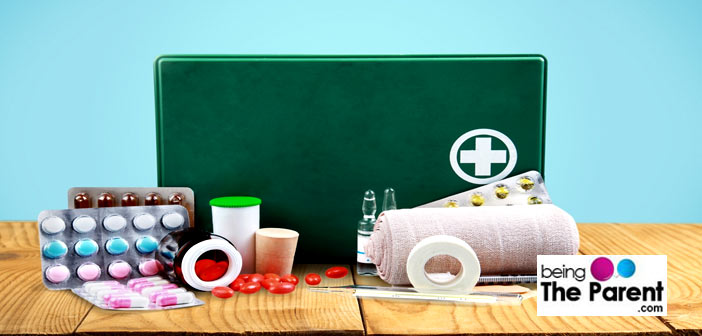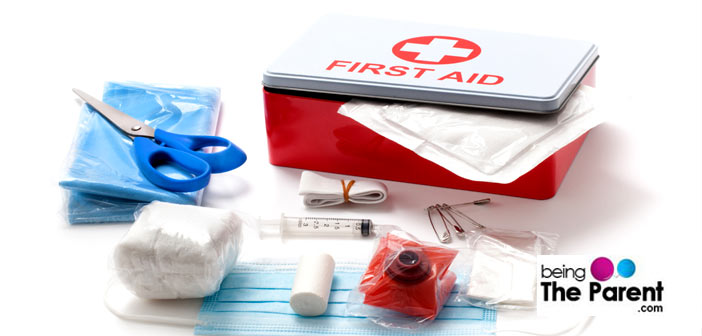 Human body is prone to accidents. Be it a minor scrape, bruise, cut or a more severe injury, you must attend to it immediately till you obtain expert medical aid. There are very few smart people out there who have all the things in place when they need them. Remember Murphy’s law? When you need an antiseptic, and the entire house has to assume the role of CID and rummage through the kitchen cabinets, bathroom, drawing room drawers and bedroom cupboard. Emergency will not greet you with prior notice, you must be prepared to face it. There should be a first aid box in your household and each one of the family member must be aware of it and easily access it.
Human body is prone to accidents. Be it a minor scrape, bruise, cut or a more severe injury, you must attend to it immediately till you obtain expert medical aid. There are very few smart people out there who have all the things in place when they need them. Remember Murphy’s law? When you need an antiseptic, and the entire house has to assume the role of CID and rummage through the kitchen cabinets, bathroom, drawing room drawers and bedroom cupboard. Emergency will not greet you with prior notice, you must be prepared to face it. There should be a first aid box in your household and each one of the family member must be aware of it and easily access it.
Why Should You Have A First Aid Kit At Home?
With kids, accidents can strike anytime. If you are prepared with a well-stocked first aid kit, it will be tad easier for you to tackle any emergency situation at a moment’s notice. We’d even say that a first aid kit that is kept easily reachable is a prime requirement in any home. You can even make seasonal first-aid kits and keep them handy. Plastic boxes, that are easy to carry, simple to open, come with handles and carry a good room would be ideal for collating the supplies.
What Should A First Aid Box Contain?

The first aid box usually contains band-aids, cotton, gauze and antiseptic. But is that all? Below are a few items that will complete the first aid box:
- Emergency numbers: The phone number of parents, few relatives or friends, residents and neighbors nearby, police, hospital and family doctor must be enlisted for quick access.
- Allergy list of all members: In case you are not around, others should be able to right medication considering any allergies.
- Over the counter medicines: You can store over the counter medicines for the most common conditions experienced in day to day life. These include:
- Headache: Dispirin, Saridon
- Stomach ache: Antacid such as Gelusil, Pudin Hara – in tablet or liquid form
- Diarrhea: Electrol powder or ORS
- Cold: Coldarin, D Cold
- Cough: Syrups
- Anti-allergic: Histamine such as Cetirizine
- Decongestant
- Painkiller: Aspirin
- Anti-itching cream: Itch guard
- Hydrocortisone cream
- Mosquito repellent cream
- Activated charcoal: Can be stored in form of tablets to fight case of acute oral poisoning
- Dropper: Some medicines need to administer by drops, especially in case of children
- Bandage and adhesive tapes: Bandage for minor cuts and bruises. Store waterproof adhesive tapes for fixing gauzes on wound
- 2″ and 4″ gauzes: Small and big gauzes to cover wound
- Scissors: Scissor is an essential tool for dressing
- Antiseptic liquid: A small bottle of Dettol or Savlon is an absolute must! If possible, you should dilute this in water before application
- Antiseptic cream: Any antiseptic cream such as Soframycin or Gentamycin will help prohibit production of germs at wound
- Antiseptic wipes: When it is not possible to wash the wound, antiseptic wipes are quite handy
- Cold pack: It is quite possible to run out of ice when you need it. Cold pack may be kept in a refrigerator or at room temperature. This instant coolant will soothe swelling and numb pain
- Tweezers: Tweezers make it easier to remove a sphincter or small foreign particles causing distress
- Latex gloves: Surgical gloves help prevent transmitting germs to an open wound
- Thermometer: Get digital thermometers instead of traditional mercury ones as they are easier to use and do not break into pieces when dropped
- Vaseline petroleum jelly: Cracked lips or heels, Vaseline has many uses. You may need to use it to lubricate rectal thermometer too
- Calamine lotion: A calamine lotion works well in soothing burn, rashes and itch. For older people it helps in fighting dry skin too
- Flashlight: A small torch is quite useful to observe wound and comes handy during dark. Make sure that the batteries are working
- Cotton and cotton swabs: Store adequate sterilized cotton and cotton swabs that can be placed over eyes or wound
- Eye drop: You can keep an eye drop which fights irritation. They can be real life saver as any discomfort to eye is unbearable

How Can I Ensure That My First Aid Box Is Up-to-date?
Below are a few tips to facilitate the use of first aid kit and protect lives:
- Its best to keep smaller tubes and one strip of medication so that the first aid kit is lightweight and not a burden to carry across
- Young kids must also educated about first aid kit and know where it is located so that in case of emergency they can direct others to find it
- Regularly check all the medicines for their expiry. Expired medicines may actually prove fatal
- You can perhaps keep two first aid kits in home, one labelled for adults and the other for kids. Remember to keep one in your car and work place too
- Create a first aid manual for the family. If your kids can comprehend the same, do share the manual with them as well
- Make sure that you check the kits at regular intervals and replace the contents
- Never, ever keep expired medicines in the first aid kit
- Make a separate ‘vacation first aid kit’ which can be easily carried when you are going on a holiday
- Keep a tab on flashlights batteries, prescription medicines and your first aid journal
Depending on the accidents that usually occur in your family, you may want to stock more medicines. Thwart an emergency, save a life and protect your family – get going with setting up your own personalized first aid box!

